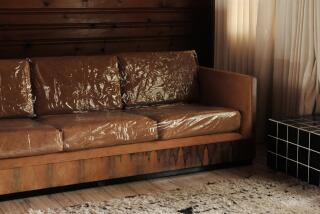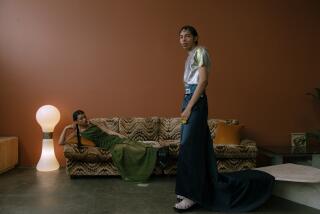Sectionals: A Piece of the Casual Action
- Share via
Remember the sectional?
This comfortable, flexible type of upholstered furniture was big through the 1970s, then faded. Now it’s back for reasons that have everything to do with style and relaxation.
Originally the seating of choice in modern interiors, sectionals are gaining ground with the return of midcentury modern decorating styles and the rise of the casual great room in place of a formal living room.
Comfortable seating that can be rearranged has obvious advantages.
“No other piece of furniture can take care of all your seating needs at once, while also making room for a crowd,” said Lyn Peterson, an interior designer and principal of Motif Designs. “The sheer size of sectionals also gives them the power to instantly pull a room together.”
In the late ‘80s and early ‘90s, those who wanted this type of seating might have had a hard time finding it. Nowadays, a large furniture store will probably offer style options in arms, backs, bases and fabrics, in addition to left- and right-arm sofas and love seats, chaises and armless corner units.
“Manufacturers are offering a bigger selection of sectionals these days,” said Rob Pitt, senior product manager for the furniture division of Crate & Barrel, a retail home-furnishings chain headquartered in Northbrook, Ill.
Drexel-Heritage Furnishings Inc. says a three-piece sectional that retails for about $5,000 and up is the most popular seating in its top-line Heritage brand. It was introduced at the High Point furniture market about 18 months ago.
Because it has done so well, Drexel is showing a new one in its less expensive Drexel line, Annette Murdock, director of marketing and upholstery, said.
Proven features such as a recliner with a pop-up footrest and a full-size sleeper are options. Retail prices start around $3,900.
*
A sectional with loose cushions at the back is more comfortable than a tight-backed style, but the latter presents a more formal appearance, which might be preferable in a living room.
Deep seats are comfortable for those who like to stretch out but can make it hard to rise gracefully. A depth of 38 to 40 inches is a good compromise, Peterson said.
Down is not the ideal stuffing for sectional units, he added. “Too high a feather content in your pillows, and you’ll spend all your time fluffin’ and puffin’. For bottom cushions, Dacron wrap with a foam core provides firm yet cushioned support.”
Because it is awkward to slipcover sectionals, the best choice is a durable fabric that won’t become outdated too soon and resists soiling or can be easily cleaned. All-over patterns or solids are good choices because they don’t require matching.
Motif Designs recently began marketing the Sectional Collection of 26 cotton and cotton/synthetic fabrics geared to this type of seating. It includes chenilles, tapestries, corduroys, wovens, plaids and textured boucles and incorporates contemporary and traditional styling. Prices range from $25 to $50 a yard.
Among many suitable options, chenilles appear to be the fabrics of choice. Drexel and Crate & Barrel say that most customers are selecting them in medium or darker colors that hide soil. Another favorite is velvet, Pitt said.
Those who remember decorating styles from the ‘50s to the ‘70s will recall that sectional pieces were often large and bulky, too big in some cases to fit through the doorway.
When space is an issue, modular rather than sectional seating is an option. (In industry terms, modular means individual seats each the same size and shape. Sectional means pieces made to go together but of different sizes and shapes.)
*
Modulars are more uncompromisingly modern than sectionals and don’t appear to have caught on to the same degree.
“Modular makes a lot of sense for those who live in small apartments and walk-ups,” Pitt said. “We don’t carry them at the moment but are thinking about it.”


